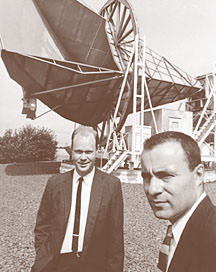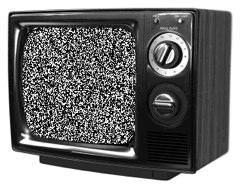[/caption]
The switch from analog to digital television broadcasting signals in the United States , which was originally scheduled for February 17th, has been postponed until June 12th, 2009. To those anticipating the higher-quality picture and more reliable signal that this switch will afford, the delay is surely a downer, though some stations may begin broadcasting digital signals before this date. You may be surprised, though, that the change in signal may no longer allow you to see leftover radiation from the Big Bang in the static on your television screen.
That’s right – when you are between channels on an analog television, the snow that you see on the screen is made up of interference from background signals that the antenna on your TV is picking up. Some of the “snow” is from other transmissions here on Earth, and some is from other radio emissions from space. Part of that interference – about 1% or less – comes from background radiation leftover from the Big Bang, called the Cosmic Microwave Background (CMB). The same is true for FM radios – when the radio is tuned to a frequency that is between stations, part of the hiss that you hear, called “white noise”, is leftover radiation from the Big Bang some 13.7 billion years ago.
In other words, your TV and radio are telescopes, good for receiving transmissions here on Earth, but really, really bad telescopes for viewing the Universe (a 1:100 signal-to-noise ratio is pretty poor). Why does your TV or radio allow you to tune into the Big Bang, however poorly? Analog television signals are basically radio waves that your television picks up, decodes, and turns into an image on your television using what’s called a cathode ray tube (CRT) in older televisions, and in newer TVs, plasma displays.
These analog signals are broadcast between 7-1002 Mhz, and TV tuners are designed to receive in this range. The CMB peaks in the microwave, at around 160 Ghz, but the frequency of CMB photons can be lower than 100 Mhz (.1 Ghz). Your television antenna is constantly being bombarded by these signals, but when it’s tuned to a specific station the overwhelming intensity of the signal at that frequency makes a crisp picture on your screen, and drowns out everything else. When your TV or radio isn’t tuned into a channel that is brodcasting clearly, it picks up whatever radio transmissions are available and displays those transmissions as the black and white static that is oh-so annoying when you are trying to acrobatically align your TV antenna and stand in just the right place to clearly show your favorite program. Here’s a short clip from First Science explaining the CMB and white noise.
Digital signals eliminate the interference while watching a program because instead of broadcasting the picture as a radio wave which communicates to the CRT or plasma screen what to “paint” on the screen by the frequency of the signal, all a digital signal communicates is a 1 or 0, and the digital converter takes care of decoding and sending information as to what the picture and sound on your screen should look like.
In fact, it was annoying “noise” that led to the discovery of the Cosmic Microwave Background in the first place. In 1965, Arno Penzias and Robert Wilson had built a Dicke radiometer for Bell Telephone Laboratories to use in radio astronomy and satellite communication experiments. Their instrument kept receiving a background signal that they could not account for. After trying everything imaginable to eliminate the noise (including removing the pigeon droppings from the telescope), they finally realized that the signal wasn’t “noise”, but photons from the Big Bang. Penzias and Wilson share the 1978 Nobel Prize in physics for this discovery, and the CMB has since been studied as a way to learn more about the beginnings of the Universe.

Televisions manufactured after March 1, 2007 for the U.S. are required to have Digital Television (DTV) tuners or be DTV ready. Some broadcasters are already transmitting TV programs in both analog and digital formats, but they will all be required to broadcast only in digital format after June 12, 2009. If you have an older television that doesn’t contain a built-in DTV tuner, you will have to buy a digital converter box. So, if you want to see static created by the CMB, unplugging the converter after June 12th will suffice. If you have a newer TV that only has a digital tuner, you will sadly be unable to experience that small percentage of influence the ancient event of the Big Bang has on something quotidian as the television in your living room.
Source: Science Talk (Scientific American) ,How Television Works


I think all of the stations in Houston are broadcasting in digital – most for a few years now. Not all are HD yet and most never will be because they can carry 2 of 3 digital channels in the same bandwidth as one HD Channel. Advertising still rules.
I have to say the same in Dallas/Ft Worth. All the stations here have been broadcasting digital at least the past year (amount of time I’ve had a digital TV). I think the local stations are itching to switch off the analog.
However when I see the static in between channels (I remember when channels shut down for the night, ay soy viejo) my first thought is not CMB, but of the TV people from Poltergeist.
The major broadcasters have been broadcasting in digital in Denver for some time. Of them all, only PBS is the only station not broadcasting in HD. Go figure.
Peace,
Drew
You can however still see The Big Bang (Theory) on CBS on Monday evenings in the USA, well worth the bandwidth!
Another conspiracy theory in the works: THEY don’t want us listening to the the Cosmic Background Radiation. Obviously, someone finds it subversive and offensive. Ian, I expect a full investigation and a series of articles to dispel this!!
When I was a child, watching ‘patterns’ was more interesting to me than looking/hearing noice when the TV networks was off the air.
Today, HD TV broadcasting is awesome.
Although I sold my home to get into a condo,
I still have my parents 21″ RCA TV bought in 1951 for $400-the cabinet is rare woods, the tubes and innards I gutted long ago and makes a great antique display case! $400 in 1951 is about $5200 today!!!
But the background radiation is more interesting than most of the regular programming!
Most regular power TV stations are already broadcasting in digital, some in HD. A small number of analog stations already went dark today, most of those in smaller markets. Where I live, all the high-power stations will be going digital around May 2.
The digital transition does not apply to low power and class-A licensed stations. So if there is a low power station that you watch, ensure that you can still get it. The coupon digital converter boxes do not include an analog tuner, so you will have to get one with “analog pass-thru” or use a splitter to connect the antenna to your analog tuner in your TV.
Note also that the coupon boxes are DIGITAL tuners and not HIGH-DEF. You will not be able to receive high-definition content with the coupon boxes. It will be downconverted to the standard NTSC 400-or-so lines of resolution that an analog television can display. If you want real high-def and have a TV or monitor that can support it, then you will need a converter box that supports HD output via component or HDMI.
Of course, if you bought your TV in the last few years it probably has a digital tuner already, to say nothing of cable and satellite viewers … they will generally have to do nothing at all.